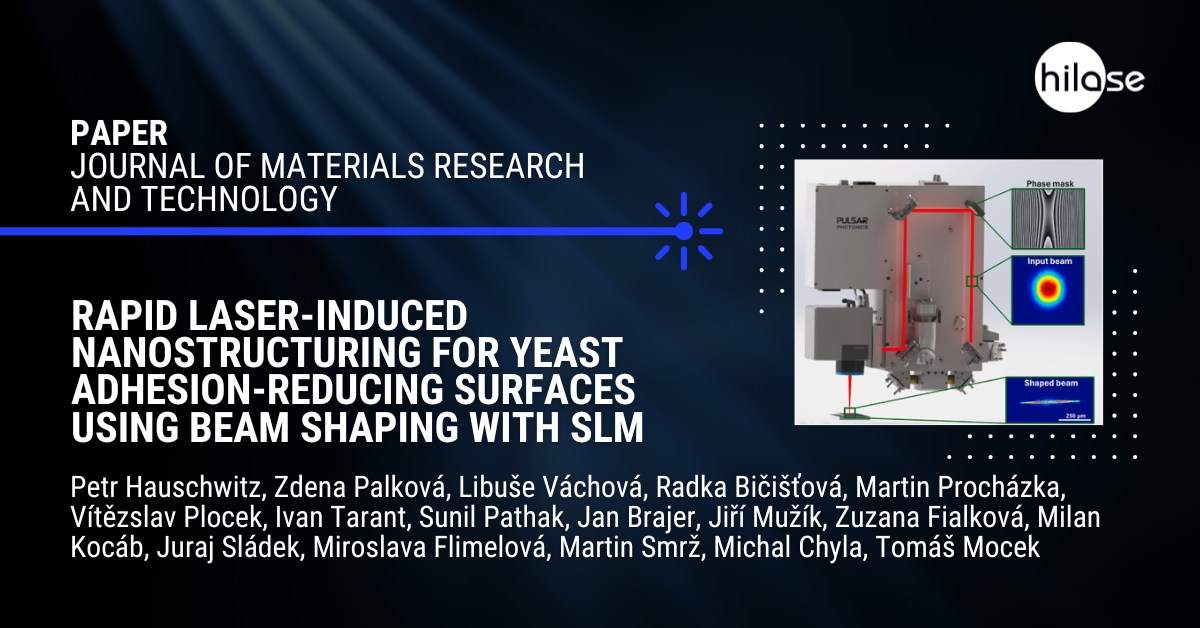Read a new research paper published in the Journal of Materials Research and Technology, authored in collaboration between the HiLASE Centre and BIOCEV.
It deals with the use of laser-induced nanostructuring to control microbial adhesion in healthcare and industry. More specifically, dynamic beam-shaping with a spatial light modulator was used to reduce the adhesion of the Saccharomyces cerevisiae as a model organism.

- Hierarchical laser-induced periodic surface structures (LIPSS) were created using a novel dual-pass laser strategy at a production efficiency of 150cm2 per minute.
- The research team observed a 95% decrease in adherent cells, with a maximum achieved reduction of 99.88%.
- These findings have important implications for healthcare and food processing, as well as other industries which can benefit from the use of biofilm-resistant surfaces.
The research team consisted of HiLASIANS mainly from the Industrial Laser Applications and Advanced Laser Development departments (Petr Hauschwitz, Radka Bičišťová, Martin Procházka, Ivan Tarant, Sunil Pathak, Jan Brajer, Jiří Mužík, Zuzana Fialková, Milan Kocáb, Juraj Sládek, Miroslava Flimelová, Martin Smrž, Michal Chyla and Tomáš Mocek) alongside a group of BIOCEV experts in the field molecular biology of yeast populations (Zdena Palková, Libuše Váchová, and Vítězslav Plocek).
“Our new study presents an effective method of laser surface processing that significantly reduces yeast adhesion by up to 99.88%. This breakthrough enables the development of surfaces with antimicrobial properties, with potential applications, particularly in the food and healthcare industries,” explains Petr Hauschwitz, team leader of Laser Micromachining at the HiLASE Centre. “Our method leverages advanced technologies for shaping and manipulating laser beams, which, combined with the powerful lasers at the HiLASE Centre, allows us to increase production speed by orders of magnitude compared to current laser nanostructuring technologies.”
“I am pleased that, together with my colleagues from HiLASE, we managed to find a surface modification within the LasApp project that significantly reduced the adhesion of our reference yeast strain. This is an important finding for the continuation of our collaboration, where we will test this promising surface for adhesivity against a range of other medically significant microbes, as well as the properties of other structures that colleagues from HiLASE will prepare. In the future, we will be able to apply our findings, for example, in the field of biomedicine or other industries where eliminating contamination by microbial biofilms is crucial,” comments Prof. Palková.
Controlling microbial adhesion in industrial and healthcare settings is crucial for maintaining hygiene and preventing biofilm formation. This work describes a novel method to efficiently produce yeast adhesion-reducing surfaces using dynamic beam-shaping with a spatial light modulator. At first, the laser-induced periodic surface structures (LIPSS) topography was tuned to test microbial adherence in a variety of LIPSS configurations, specifically using Saccharomyces cerevisiae as a model organism. A novel and robust dual-pass laser strategy was implemented to create hierarchical LIPSS structures with periodicities of 630 nm and 5 μm. The integration of dynamic beam shaping with spatial light modulator (SLM) significantly enhanced production efficiency, achieving a throughput of up to 150 cm2/min. The laser-structured surfaces exhibited a significant reduction in yeast adhesion, with a decrease of 95% in adherent cells and achieving a maximum reduction of 99.88%. These findings offer promising implications for developing advanced surface treatments to improve hygiene in industries such as food processing and healthcare, where minimizing microbial colonization is vital.
This work was co-funded by the European Union and the state budget of the Czech Republic under the project LasApp CZ.02.01.01/00/22_008/0004573.








